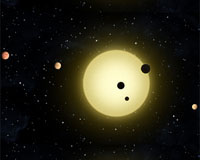| . |  |
. |
Paris (AFP) Feb 2, 2011 Astronomers said on Thursday they had found six planets orbiting a distant star in the most exciting but also most challenging find since exploration of other solar systems began 15 years ago. None of the so-called exoplanets, orbiting the star Kepler-11 2,000 light years away, is remotely comparable to the Earth, but the detection of them is a major technical feat, the scientists said. Five planets are relatively small, ranging in mass from 2.3 to 13.5 times that of Earth, but orbit Kepler-11 at blistering proximity, encircling it at a distance that is even closer than Mercury to the Sun. Their "year" -- the time it takes to encircle the Sun -- is less than 50 days. A sixth exoplanet is large and farther out, with an orbital period of 118 days, and is of a yet-to-be determined mass, although it is likely to be a "gas giant" like the outer planets of our own Solar System. Reporting their find in the British journal Nature, the astronomers said the star system was mind-boggling because the planets were so small, so numerous and yet so densely packed. "We think this is the biggest thing in exoplanets since the discovery of 51 Pegasi b, the first exoplanet back in 1995," Jack Lissauer of the NASA-Ames Research Center said in a teleconference with the media. Daniel Fabrycky, a post-doctoral researcher at the University of California at Santa Cruz, described it as "an amazing planetary system." "Of the six planets, the most massive are potentially like Neptune and Uranus, but the three lowest-mass planets are unlike anything we have in our Solar System," added Jonathan Fortney, the university's assistant professor of astronomy and astrophysics. The inner planets seem to have an atmosphere of water or hydrogen-helium gas. This is another surprise, given the presumption that a small planet orbiting so close to a star would have a light atmosphere blasted away by solar radiation. The extra-solar bodies were found by the US orbiting telescope Kepler, which already has a fine haul of these so-called exoplanets to its credit. Kepler-11's herd of planets orbit in very narrow planes. Sideways on, as viewed from Earth, "the system is flatter than a CD," said Lissauer. The diameter of the planets were calculated using a highly-sensitive light sensor, a photometer, which detected changes in the star's brightness when the planets moved in front of it. This is now a time-honoured approach in exoplanet work. More than 500 exoplanets have been spotted since 1995, of which around 100 have been detected using this "transit" method. Where the new work differed is a novel way of calculating the planet's masses. Until now, this was done by using ground-based telescopes whose Doppler spectroscopy measures a "wobble" in starlight caused by the gravitational tug of the passing planet. This has been great for measuring very large planets that are, say, the size of our own Jupiter. But it is not refined enough for estimating the mass of smaller planets that are little bigger than Earth. The team used orbital dynamics to get around this for the Kepler-11 planets. They measured tiny variations in the orbital periods caused by gravitational interaction among the tightly-packed planets themselves. Improvements such as this are part of an essential toolkit for spotting another Earth-like planet which could support life as we know it. It would have to be a rocky planet, as opposed to one made out of gas, and it would have to orbit in the famous Goldilocks Zone, where the temperature is neither too hot nor too cold, but just right for water to exist in liquid form.
Share This Article With Planet Earth
Related Links Lands Beyond Beyond - extra solar planets - news and science Life Beyond Earth
 Earth-Size Planet Candidates Found In Habitable Zone
Earth-Size Planet Candidates Found In Habitable ZonePasadena, CA (SPX) Feb 3, 2011 NASA's Kepler mission has discovered its first Earth-size planet candidates and its first candidates in the habitable zone, a region where liquid water could exist on a planet's surface. Five of the potential planets are near Earth-size and orbit in the habitable zone of smaller, cooler stars than our sun. Candidates require follow-up observations to verify they are actual planets. Kepler ... read more |
|
| The content herein, unless otherwise known to be public domain, are Copyright 1995-2010 - SpaceDaily. AFP and UPI Wire Stories are copyright Agence France-Presse and United Press International. ESA Portal Reports are copyright European Space Agency. All NASA sourced material is public domain. Additional copyrights may apply in whole or part to other bona fide parties. Advertising does not imply endorsement,agreement or approval of any opinions, statements or information provided by SpaceDaily on any Web page published or hosted by SpaceDaily. Privacy Statement |